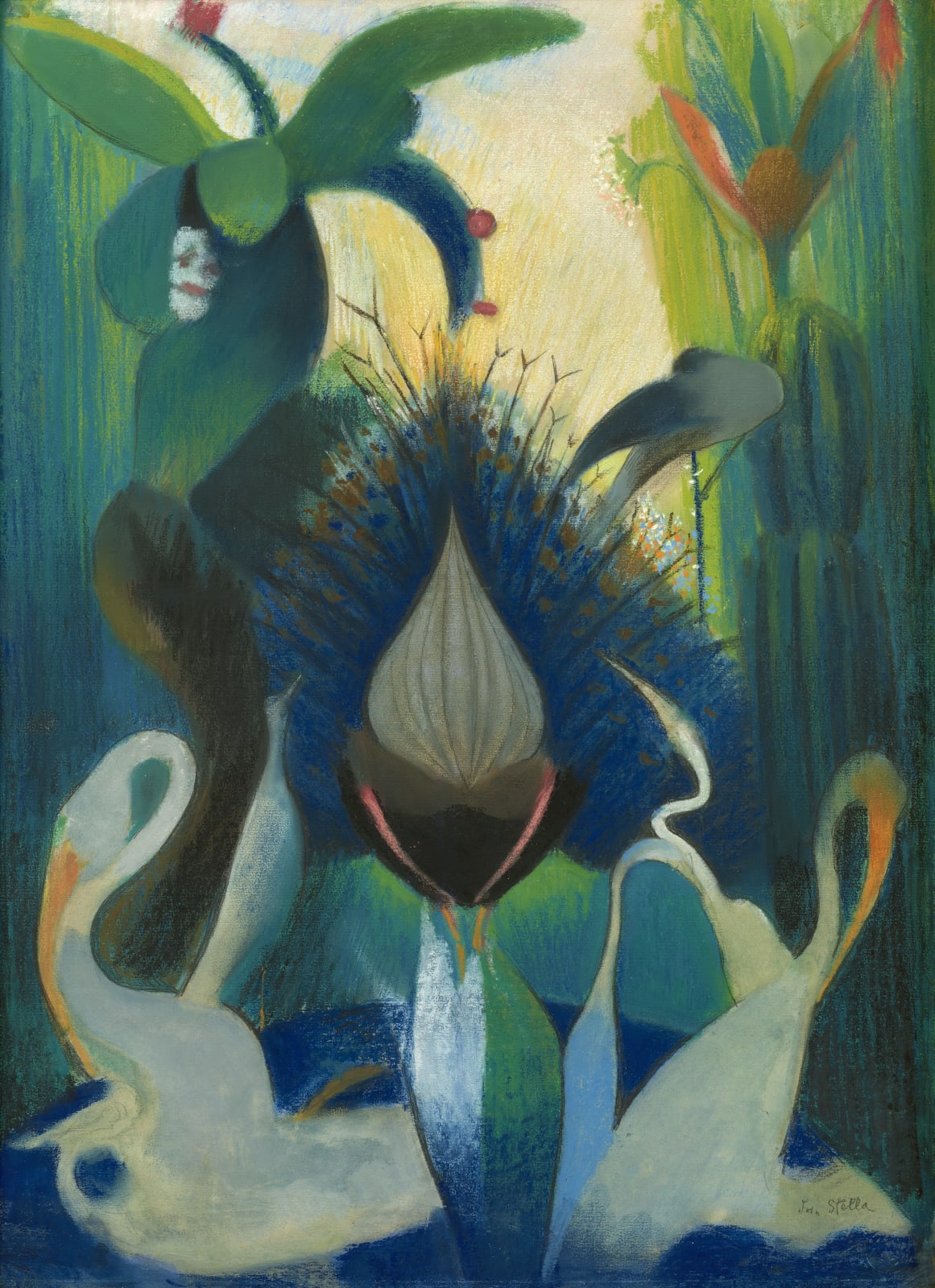Joseph Stella Italian, American, 1877-1946
64.1 x 46.4 cm
The years 1912-19 mark a turning point in the international avant-garde movement. Futurism was at the fore; brilliantly colored abstract paintings were devoted to reflecting large scale, industrial might, and dynamic activities of a modern world. The “Futurist Manifesto,” crafted in 1907, embraced modernity and eschewed commercialism, and of course contained a radical political element which must have appealed to Joseph Stella, an Italian-born artist who came to America at the age of nineteen. Previously, Stella created an extensive series of evocative drawings that address the plight of immigrant workers and their experiences seeking a future in the “new” United States. Modernity embraced and repulsed change, and the young immigrants to America were its most acute victims. Stella can be considered among its most sensitive and evocative chroniclers.
Following the great success of the first exhibition of Post-Impressionism in 1910-11, the travelling exhibition of the upstart Italian Futurists seized commercial and critical attention in 1912 both in London and Paris. There was rich disdain and also emphatic applause. Stella was among the American artists whose life and career were transformed by the events during these years. He exhibited at the jarring Armory Show in New York in 1913, developed a longstanding relationship with Marcel Duchamp, and investigated Dada. Stella bathed in modernity, and his career grew to greatness in these important years.
Between 1912 and the early 1920s, Stella created many of his signature canvases such as Battle of Lights, Coney Island, Mardi Gras and Brooklyn Bridge (both Yale University Art Gallery; 1913-14 and 1919-20); The Voice of the City of New York Interpreted (Newark Museum; 1920-22); and the 1919 epic Tree of My Life (Art Bridges) to which Peacock relates. Stella's work migrated in this period from intimately scaled color studies to these titanic canvases which are among the masterworks of American modernism. After 1919, Stella retreated back to the small-scale drawings, pastels, and paintings which are devoted to nature, flora, and fauna.
The Peacock is among the most elegant and beautiful of Stella’s works and a tour de force in his adoption of pastel as a significant medium. The pastel was exhibited in Stephan Bourgeois’s important 1920 retrospective exhibition of the artist’s work. Degas, Manet, Cassatt and other modern artists a generation older had introduced pastel into their modern practice. Stella coveted the pastel medium and deployed it frequently despite its European appeal and lack of acceptance by an American audience. In this breathtaking example, Stella attends to the medium's inherent beauty and the dynamic palette he savored. As always, he joined the raucous palette with a deft hand developed during his early investigations inspired by the 15th-century icons of his Italian homeland.
Stella’s Peacock may relate to a series of works on the subject by Natalya Goncharova created between 1910-16. Goncharova’s depictions of peacocks in a Futurist mode were well-known paintings by the important young Russian artist and relative of Pushkin. Dynamic and modern at its core, Stella’s Peacock hews toward the hallmark explorations he devoted to a fanatical fascination with nature. These works resemble a moment of peace and natural beauty amidst World War I and the attendant cultural clashes.
Nature, in Stella’s hands, is both a modern element and steady source of refuge from the rapid changes in art and culture. After around 1919 Stella devoted the majority of his time to more intimate explorations of natural subjects, and composed still life paintings, retreating from the negative imagery of post-World War I America. In remembering his 1919 magnus opus Tree of My Life, Stella remarked, “A new light broke over me, I found myself in the midst of a joyous singing and delicious scent . . . of birds and flowers ready to celebrate the baptism of my new art.” The Peacock evokes the powerful spirit of this new direction in Stella’s art.
Provenance
[Bourgeois Galleries, New York];[Andrew Crispo Gallery, New York, 1974];
[Richard York Gallery, New York, by 1994]; to
Private collection, New York, by 1996 until 2022
Exhibitions
Bourgeois Galleries, New York, Retrospective Exhibition of Paintings, Pastels, Drawings, Silverpoints and Watercolors by Joseph Stella, March 27-April 24, 1920, no. 42Colony Club, New York, Modern Sculpture, Water Colors and Drawings, April 2-13, 1922, no. 176
Whitney Museum of American Art, New York, Joseph Stella, April 22-October 9, 1994
Nassau County Museum of Art, Roslyn Harbor, New York, American Vanguards, January 21-April 28, 1996
Norton Museum of Art, West Palm Beach, Florida; High Museum of Art, Atlanta, Georgia; and Brandywine River Museum of Art, Chadds Ford, Pennsylvania, Joseph Stella: Visionary Nature, October 15, 2022-September 24, 2023
Literature
Irma B. Jaffe, Joseph Stella, Cambridge, Massachusetts: Harvard University Press, 1970, p. 207 (no. 298 in Appendix IV)Barbara Haskell, Joseph Stella, New York: Abrams, 1994, p. 63, illus. fig. 76

